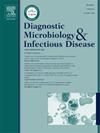The neurocysticercosis puzzle: A case of chronic cephalalgia and hydrocephalus
IF 1.8
4区 医学
Q3 INFECTIOUS DISEASES
Diagnostic microbiology and infectious disease
Pub Date : 2025-07-18
DOI:10.1016/j.diagmicrobio.2025.117020
引用次数: 0
Abstract
Neurocysticercosis (NC) is the most common helminthic CNS infection, primarily affecting individuals from endemic regions. We present the case of a 33-year-old Peruvian woman, who had been residing in Spain for over a decade, who experienced recurrent episodes of severe headache, vertigo, and diplopia. Initial evaluations revealed tetraventricular hydrocephalus with unclear etiology. Over the course of a year, she underwent multiple hospitalizations, being diagnosed with retinal toxoplasmosis. Serological testing revealed Taenia solium IgG antibodies. Despite inconclusive neuroimaging, she was treated with albendazole and corticosteroids, leading to symptom improvement. However, mild headaches persisted. Years later, a CT scan revealed a calcified cysticercus in the fourth ventricle, confirming the diagnosis of ventricular NC. This case underscores the diagnostic challenges of NC, particularly in atypical presentations. A multidisciplinary approach combining serology, neuroimaging, epidemiological risk assessment and clinical history is crucial for early detection and management. Long-term follow-up is essential to monitor sequelae and ensure optimal outcomes.
神经囊虫病之谜:慢性脑痛和脑积水1例
神经囊虫病(NC)是最常见的中枢神经系统蠕虫感染,主要影响流行地区的个体。我们报告一名33岁秘鲁妇女的病例,她在西班牙居住了十多年,经历了反复发作的严重头痛、眩晕和复视。初步评估显示四室脑积水病因不明。在一年的时间里,她多次住院,被诊断为视网膜弓形虫病。血清学检测显示猪带绦虫IgG抗体。尽管神经影像学不确定,但她接受阿苯达唑和皮质类固醇治疗,导致症状改善。然而,轻微的头痛仍然存在。多年后,CT扫描显示第四脑室有钙化囊虫,确认了脑室NC的诊断。该病例强调了NC的诊断挑战,特别是在非典型表现中。结合血清学、神经影像学、流行病学风险评估和临床病史的多学科方法对早期发现和治疗至关重要。长期随访是监测后遗症和确保最佳结果的必要条件。
本文章由计算机程序翻译,如有差异,请以英文原文为准。
求助全文
约1分钟内获得全文
求助全文
来源期刊
CiteScore
5.30
自引率
3.40%
发文量
149
审稿时长
56 days
期刊介绍:
Diagnostic Microbiology and Infectious Disease keeps you informed of the latest developments in clinical microbiology and the diagnosis and treatment of infectious diseases. Packed with rigorously peer-reviewed articles and studies in bacteriology, immunology, immunoserology, infectious diseases, mycology, parasitology, and virology, the journal examines new procedures, unusual cases, controversial issues, and important new literature. Diagnostic Microbiology and Infectious Disease distinguished independent editorial board, consisting of experts from many medical specialties, ensures you extensive and authoritative coverage.

 求助内容:
求助内容: 应助结果提醒方式:
应助结果提醒方式:


